Rogue Elephant
What happened when the Republican mayor of Carmel, Indiana, bucked his party and embraced sustainability? He got reelected—four times.
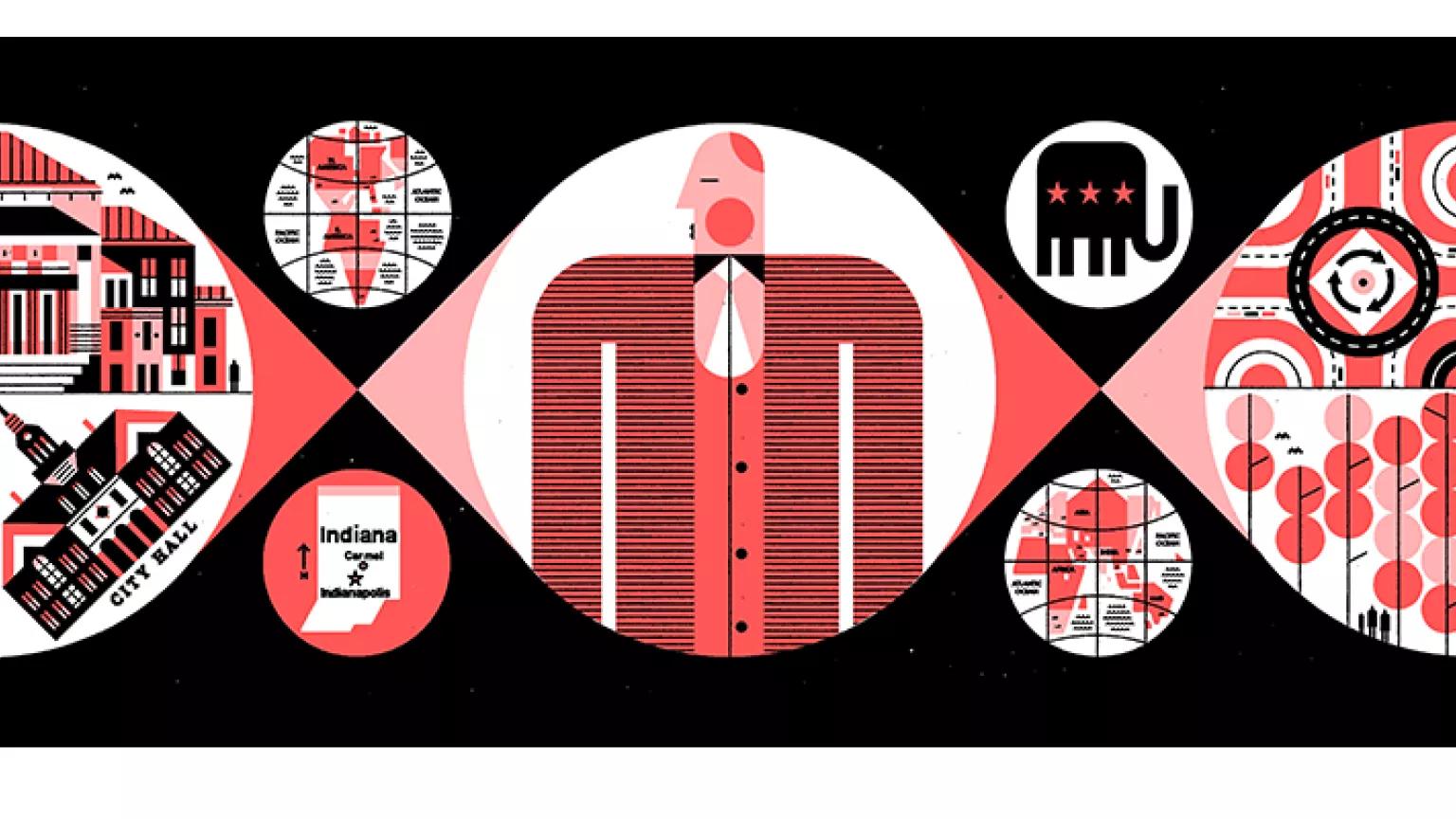
Not long ago, on the stage of the Palladium performing arts center in Carmel, Indiana, the Carmel Symphony Orchestra welcomed a very special musical guest. Sitting in on French horn that evening was none other than the city’s mayor, Jim Brainard. Three years earlier, the doors had opened on the 154,000-square-foot Palladium, encased in locally quarried Indiana limestone and inspired by La Rotonda, the majestic 16th-century villa in Vicenza, Italy, built by the Renaissance architect Andrea Palladio. This world-class concert hall is the cornerstone in a civic rejuvenation project that Mayor Brainard has been shepherding since he first assumed office nearly two decades ago. As a token of their appreciation, the musicians who now make the Palladium their seasonal home invited him to perform with them—and not just any old piece of music, either, but the famously complex work of Gustav Mahler.
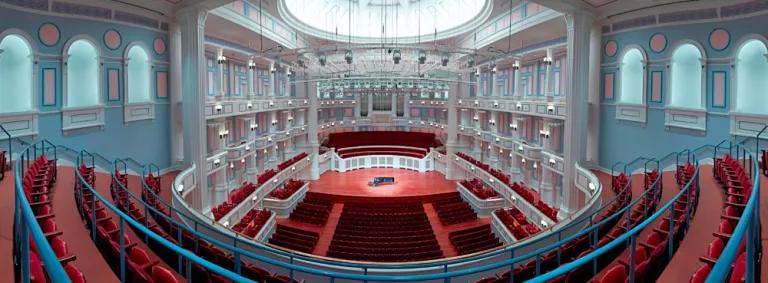
The Palladium, which opened its doors in 2011, can seat 1,600 music lovers.
Which is only fitting for a mayor who is his own kind of civic maestro. Carmel, 15 miles north of Indianapolis, is a solidly conservative suburb of a predominantly conservative city in a state that has been won by the Republican candidate in 9 out of the last 10 presidential elections. But if you think Carmel’s political demographic profile would automatically make its 85,000 residents wary of any mayor who routinely rides his bicycle to work, describes himself as “mostly” vegetarian, cheers the shuttering of coal-fired power plants in this coal-friendliest of coal-friendly states, and believes openly in anthropogenic climate change, then you’d be mistaken. Apparently this bothers them no more than the fact that this 60-year-old mayor—who also happens to be a lifelong Republican—has effectively remade their once-sleepy bedroom community into a city that now gets celebrated on magazine covers and even attracts media attention from overseas for the unique way it approaches redevelopment and city planning.
The Palladium is central to Brainard’s vision of what makes for a great city, both culturally and physically. In 1981, while pursuing a law degree, he spent a year studying at Oxford University. Since then he’s traveled extensively throughout Europe, all the while absorbing the cogency and eloquence of town squares in cities across the continent. “The first thing I do in a European city,” he says, “is find a table in a café on the main square and watch the world go by.” What Siena’s Piazza del Campo and London’s Trafalgar Square have in common is a dedication to civic cohesiveness—in Brainard’s estimation, a quality that’s gone missing in far too many American towns. He says he expects the Palladium to stand for at least five centuries. And he is determined to make sure Carmel will be around to enjoy it for just as long.
* * *
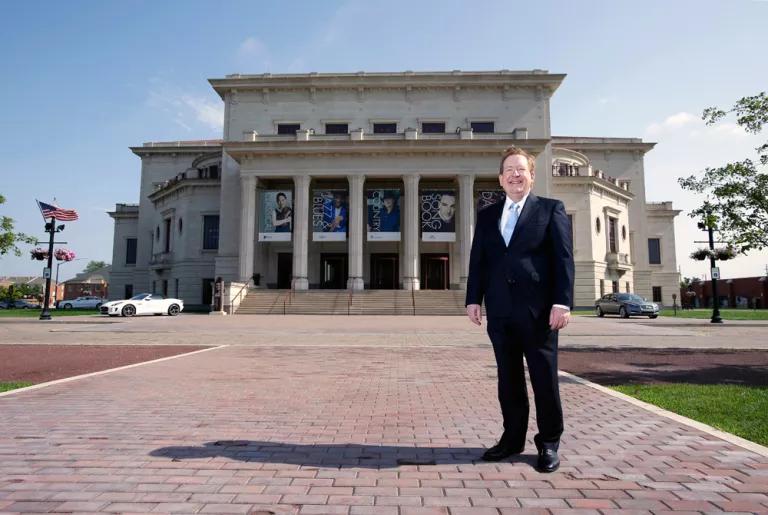
Brainard, an Indiana native and married father of four, has ginger hair and a wry and ready smile. His manner is deceptively unassuming. Currently serving an unprecedented fifth term in office, he affably returns hellos and deflects compliments from supporters he meets on the streets, of which there are many. He’s quite comfortable making his way through crowded sidewalks, parks, and plazas of the sort that he encountered on his European travels; their examples, in fact, have inspired his ongoing campaign to redefine community in his own hometown. The Palladium concert hall is the implanted nucleus around which a central, walkable, connected downtown Carmel is now coalescing. Since first assuming office in 1995, Brainard has been steadily transforming his city into a model for how other small cities of the 21st century can use sustainable urban policy to court economic growth, increase populations, beautify public spaces, and greatly improve local quality of life—all while reducing the greenhouse gas emissions that cause global warming.
On this last point Brainard long ago established his bona fides. Since 2005, he has been cochairing the Energy Independence and Climate Protection Task Force for the U.S. Conference of Mayors, which has been instrumental in convincing American cities to adopt goals toward lowering their carbon emissions. A year ago President Obama selected him to sit on the president’s State, Local, and Tribal Leaders Task Force on Climate Preparedness and Resilience. After four White House meetings, the 26-person panel is now winnowing a slew of recommendations to present to Obama in November.
Meanwhile, back in Carmel, the Brainard administration continues to find new ways of folding sustainability into the workaday business of city management. Municipal workers, for example, now drive hybrid and biofuel vehicles down roads newly planted with hundreds of trees as part of a citywide goal to achieve 50 percent tree-canopy coverage on all of Carmel’s streets. A new, interconnected system of pathways and sidewalks encourages cycling and walking. And when it came time to update the local wastewater treatment plant, the city opted for a technology that kills bacteria with ultraviolet light rather than chlorine. (Even trace amounts of residual chlorine in treated and discharged wastewater can be harmful to aquatic life.)
It’s significant that Brainard is doing all this as a Republican (one of only four on Obama’s Local Leaders team). He shrugs off any suggestion that his sustainability ethic somehow represents a break with Republican tradition, citing such conservation-minded GOP forerunners as Teddy Roosevelt, who vastly expanded the National Parks system; Dwight D. Eisenhower, who created the Arctic National Wildlife Refuge; and Richard Nixon, who signed the papers to establish the Environmental Protection Agency. But more to the point, he maintains, no daylight exists between the Brainard administration’s approach to city management and the Republican Party mandate to generate and maintain stable, prosperous communities unburdened by high taxes.
Brainard, loyal Republican that he is, is doing all that. But he’s also doing a lot more—which is apparent to anyone who spends a day or two, as I did, walking around the city he leads. Carmel is being reconfigured according to planning principles that, for many centuries, organically guided the way cities developed—but that, in the era of the automobile, required a renaissance. This renaissance began to take shape in the 1980s in the form of New Urbanism: a design movement that emerged in opposition to midcentury conventions of suburban development whose organizing principle was, irreducibly, the car. In the cultural equation New Urbanism sought to redress, postwar prosperity plus automobiles plus inexpensive suburban housing yielded a depressing civic sum: sprawl, smog, the physical and economic dissolution of downtowns, and social anomie.
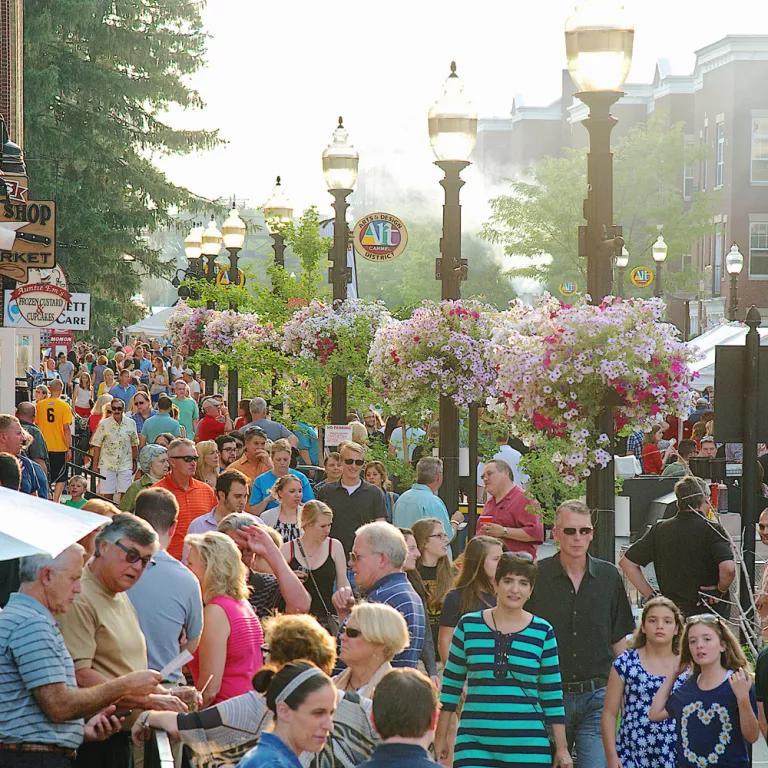
Carmel has taken its place near the top of a growing list of cities and towns prioritizing the benefits of walkable neighborhoods, their avenues marked by mixed-use development and sidewalks abuzz with human activity, over the “benefit” of being able to drive from a (rigidly zoned) residential development to a giant parking lot in a (rigidly zoned) commercial district. Nevertheless, while the precepts of New Urbanism may have saturated the consciousness of the many planners and architects who advocate for smart growth, transferring that awareness into action at the municipal level is another matter entirely. Brainard has made doing so a personal, political, and civic goal. Eighteen years into his tenure, Carmel—still a work in progress—now serves as a kind of pilgrimage destination for officials from towns all over the country who have awakened to the promise of smart growth, and who want to see it in action.
* * *
Founded by Quakers in the early 1800s, Carmel enjoyed modest prosperity as an agricultural community for more than a century. But by the middle of the 20th century it had lost its identity. Perched as it was just north of Indianapolis, the hamlet was caught betwixt and between. The expanding Hoosier capital had begun to squeeze out farms, and in 1958, as the population hovered at 1,500, the Indianapolis Star described the town as “a dormitory for suburbanites.” (And so it would remain, predicted the newspaper.) But the ’60s brought an onslaught of road construction, including a link to the interstate, and a new, more robust kind of prosperity. Corporate and banking ventures arrived, along with a steady surge of residential development in true post–World War II tradition: subdivisions with single-family homes; far-flung schools, offices, and shopping centers; capacious parking lots. Three decades and a thousand traffic jams later, Brainard stepped into office resolved to switch things up.
He started with roundabouts. To date Brainard has removed more than 80 traffic signals and replaced the corresponding intersections with these imported traffic-control measures. A roundabout is, effectively, a gear that revolves on demand. Unlike a traffic signal, it doesn’t “control” traffic so much as facilitate it. And unlike the rotary—the roundabout’s daunting, multilane cousin, with its weaving, speeding cars and macho imperviousness—the roundabout is small, just one or two lanes, and tame. Joining a stream of drivers on one in Carmel is about as intimidating as stepping behind the wheel of a rotating conveyance on a kiddy ride. Roundabouts simultaneously compel cars to slow down and keep moving. They save driving time and dramatically reduce the number and severity of traffic accidents, since sideswipes at slow speeds are far less calamitous than T-bones at high speeds. (Karmic symmetry: In 1923 the very first traffic signal in the United States was invented, manufactured, and installed right here in Roundabout City.) Significantly, roundabouts also curb emissions generated by engines as they idle at stoplights.
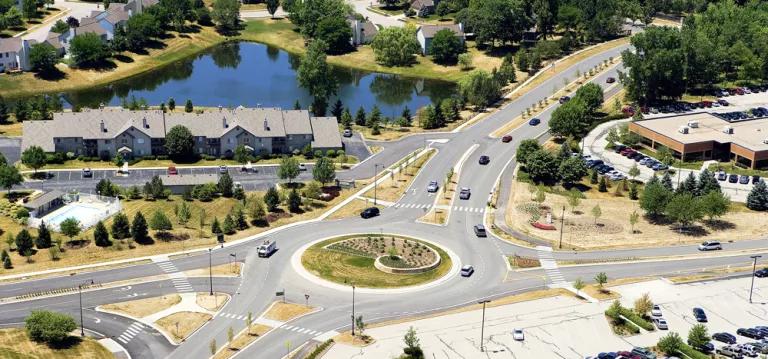
uring my visit, while I was roundabout-hopping on a drive with the mayor, a radio newscaster announced that Indianapolis Power & Light would be converting its downtown electrical plant from coal to natural gas. “Just what we’ve been waiting for!” Brainard exclaimed. IPL currently has the dubious distinction of operating the last remaining coal-fired power station within the confines of a major Midwestern city. The privately owned utility had long been under pressure to phase out coal, but in Indiana—the seventh-largest producer of coal in the United States—resistance was stiff. The final nudge came in June when President Obama empowered the EPA to enforce more robust carbon pollution standards for the energy sector. “That station impacts our health here in Carmel and throughout the metro area,” Brainard told me. “And it’s especially bad for people who can’t afford to live anywhere but in the vicinity of the plant. Natural gas is a fossil fuel, but it’s a good transitional source of power until we can provide more energy from renewable sources.”
Though he may seem to stray from the party line, Brainard is a Republican both by inclination and necessity; in this GOP stronghold, mayoral elections are decided in the primaries. Yet he is forthright in his views on climate change: It’s real, it’s serious, and it’s nothing to be coy about. “Why would I argue with 97 percent of scientists?” he asks, insisting that clean air and stable climatological patterns are, or should be, politically neutral objectives. What’s notable here may not be his perspective so much as his transparency—and the fact that such transparency doesn’t seem to have hurt him at all, politically speaking, among Carmel’s conservative voters.
That makes sense to smart-growth advocate Jeff Speck, an urban planner and the author of Walkable City, a rollicking treatise on the imperatives of urban and suburban reinvention. Speck says he counts more than a few Republicans among his urban-planning clients. “Fiscal conservatives are beginning to understand the economics of automobility and how suburbia fails to pay its own way,” he says. “They also want to attract talent to their cities and acknowledge the desires of millennials, the vast majority of whom want to live in walkable communities.” That quest for new creative energy has helped fuel one of Brainard’s primary goals: crafting an environment that will entice people to move to his city. Since he took office in 1995, Carmel’s population has almost tripled. And in 2012, CNN Money magazine endorsed his efforts by awarding Carmel the top slot on its list of the 100 best places (population 50,000 to 300,000) to live in America; this year it came in number three.
Even while Brainard was campaigning, voters made known their expectations. They wanted better traffic management, more parks and trails, and a downtown that was both accessible and appealing. Change was on the docket, but it’s unlikely Carmelites foresaw just how sweeping that change would be. As he explains: “Sometimes leadership requires that government move ahead before there is consensus. We did exactly that—and the public liked the result, which made it much easier for us to continue over the years.”
The old saying that the government closest to the people is the best government is true. Mayors don’t have the luxury of endlessly debating these issues; they are simply charged with making improvements and judged by the results.
His constituents’ response illustrates a modern political truth: More so than other public officials, mayors are well positioned to innovate and to act. The costs and threats of climate change certainly qualify as a national concern, but at the federal level, congressional action is routinely thwarted by the vagaries of partisan politics and competing agendas. Mayors, by contrast, must live and work among their constituents, which streamlines accountability. “The old saying that the government closest to the people is the best government is true,” Brainard says. “And as a result, local governments are much more efficient and responsive. Residents see the effects of climate change and weather disasters firsthand and want action taken. They also want clean drinking water and air. Mayors don’t have the luxury of endlessly debating these issues; they are simply charged with making improvements and judged by the results.”
For this mayor, those results are accumulating. “We don’t have mountains, we don’t have a shoreline, and we don’t have year-round 72-degree temperatures,” Brainard says, listing some of the perks other cities can boast in the never-ending contest to attract young people, families, and businesses. “But neither does Paris,” he adds with a drolly raised eyebrow. Hubris aside, the mayor is convinced the built environment will always be key to his city’s appeal and potential.
* * *
My August visit to Carmel happened to coincide with a spell of glorious weather of the southern California variety that the mayor tries not to envy. The days were temperate, sunny, and dry. The city showed off handsomely as I strolled the half-mile along the Monon Trail from Carmel’s Arts and Design District to the area known as City Center. The Monon is a 16-mile (and growing) rail-to-trail corridor that follows part of a train route that once ran from Chicago to Louisville. Its five-mile section running through Carmel binds the east and west sides of town like a zipper, pulling the city together. But it’s also Carmel’s answer to the Seine. The trail unspools picturesquely, drawing residents and visitors to its flanks for food, drink, outdoor concerts, and people-watching. There’s even a museum—are you listening, Paris?—run by the Carmel Clay Historical Society and housed in the charmingly restored Monon train depot.
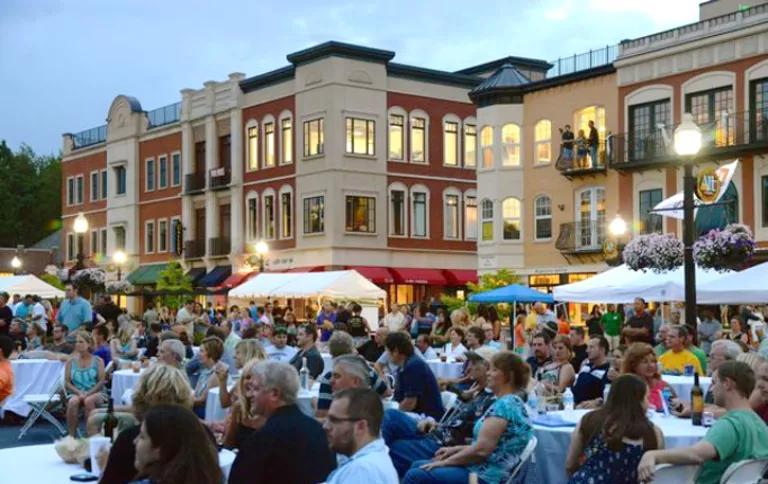
The emergence of the Arts and Design District has revived Carmel’s old, decaying downtown from its decades-long decline. With its mix of repurposed original buildings and new but period-sensitive construction, the area is now home to design ateliers and showrooms, art galleries, specialty retailers, restaurants, a music school, and more. Residential units are mixed in, generally above the businesses. The neighborhood that fans out to the north contains photogenic vintage homes of varying sizes and states of repair, as well as new construction that mimics the old housing stock but adheres to sustainable building standards. It’s all walkable—and walking is what plenty of people do.

The stretch of the Monon linking the Design District to City Center is, at present, unprepossessing. The aesthetics will come, but for now this section, known as Midtown, bisects a brownfield site. A hulking water tower is all that commands the eye. But as one heads south, the Palladium heaves into view like a mirage, and it sets the visual tone for City Center: classical, august, impressive. The buildings around it (some complete, some under construction, some still in the planning stage) are large, neo-Georgian affairs, though they aren’t visually monolithic. Instead, these structures tend to showcase varied interpretations of the style, sometimes even within the context of a single facade: a visual dynamism that reflects the mixed-use identities of the buildings themselves. Across a sun-drenched greensward from the Palladium, for example, a separate complex houses two smaller performance venues, along with expansive office space and a number of high-end residential units. Parking is tucked out of sight, out of mind.
Speck and Associates, the design firm founded and overseen by author and urban planner Jeff Speck, has been commissioned to conceive and carry out the ambitious, multiphase plan for Midtown’s overhaul, which is slated to begin next spring. The plan’s design principles specify four conditions the project must meet in order to make Midtown into the walker’s haven that both Speck and Brainard envision. First, it must give residents a reason to walk; then it must make that walk safe, comfortable, and interesting. These conditions sound so elemental that, at first glance, they may seem glib. But as one peruses the design, with its granular attention to the scope of human appetite and behavior, it becomes clear that incentive, safety, comfort, and charisma do indeed factor into every component of the plan. When Midtown is complete, says Speck, City Center and the Design District “will be connected by a third [district] into a unified whole, and Carmel will achieve a critical mass of walkable urban fabric—enough to welcome residents who want to live fruitfully without a car.”
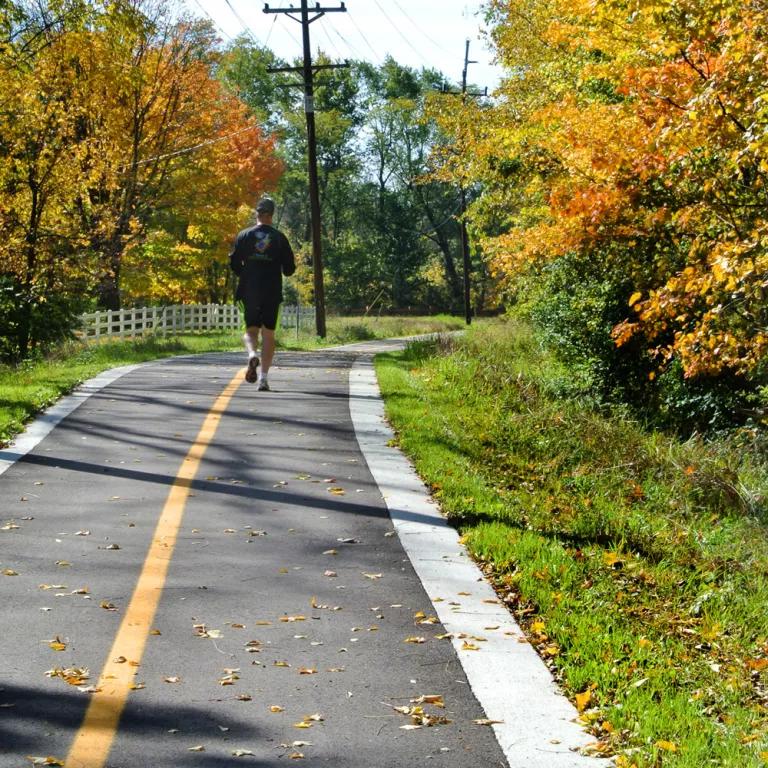
A pedestrian (or runner or bicyclist or cross-country skier) proceeding south on the Monon Trail from City Center soon encounters the 161-acre Carmel Clay Central Park, which includes 60 acres of woodland, 40 acres of recovered prairie, 6.5 acres of wetlands, and more than 4 miles of trails, as well as a water park and a thriving indoor recreational and community center. The Monon glides right through the heart of the reserve, which is the centerpiece of a park system that has expanded from 40 acres in the early 1990s to almost 1,000 today. After a 200-year interruption, during which time much of it served as farmland, Central Park has recently been restored to its native state. Great care is lavished on keeping it that way. Bioswales—vegetation-covered drainage culverts that effortlessly blend into the landscape because they are the landscape—envelop the parking lots, purifying rainwater of car pollutants before the runoff can make its way down to a nearby lagoon. The lagoon is actually a water storage and treatment facility, which manages not only runoff but also gray water from the water park before these filter into the watershed. On a sparkling summer day, Central Park’s trails—flanked in native plants such as Indian grass, larkspur, prairie clover, elderberry—feel serenely primeval.
* * *
When I solicit opinions from Carmelites regarding the mayor’s impact on their city, the overwhelming consensus—among city officials and randomly selected pedestrians alike—is that Carmel simply wouldn’t be Carmel without his particular combination of vision and confidence. Brainard’s administration has overseen the influx of tens of thousands of jobs, as major corporations (such as MISO, which controls the electrical grid for much of the eastern half of the country) have moved their headquarters here and others (such as insurance giant Geico) have set up major satellite operations. He’s kept property taxes in check—of Indiana’s 117 cities, Carmel’s tax rates are ninth-lowest—while home values have steadily ticked up. All this helps to burnish the city’s reputation as a beacon of Midwest prosperity. And it’s hard to overstate the pride of place that comes with finishing up a day’s work writing computer code in your suburban Indiana office, then strolling across the plaza to hear Wynton Marsalis or the Vienna Boys Choir run through their repertoires in a concert hall that would impress a Renaissance-era nobleman.
But the mayor has his detractors, and some of them sit on the City Council. They are worried about the pace of Carmel’s growth, and how such growth may affect taxpayers’ ability to meet the city’s debt obligations over the long term. These worries mainly center on the funding mechanisms known as tax increment financing, or TIFs. TIFs work by leveraging the anticipated increased tax revenues at a project site to underwrite its development. If the value of a TIF site or district doesn’t climb according to schedule, however, the city must reach into its coffers to finance the debt. So far, despite some construction delays and revenue shortfalls during the recession, TIFs have served Carmel well. But city councilman Rick Sharp, who is himself considering a run for mayor in the next election, has expressed concern that this state of affairs won’t last and in doing so has raised the specter of a need for higher taxes. Undeterred, Brainard continues to have faith in his development strategy. And it would appear that Standard & Poor’s backs him up: Based on the credit-rating agency’s latest assessment of the city’s fiscal management, including its ability to cover its debts and expenditures, it recently raised Carmel’s bond rating to AA+.
At the bustling farmers’ market that pops up every Saturday morning from May to September on Center Green, adjacent to the Palladium, a young woman stands behind her display of summer-harvest bounty, munching on a fat red tomato as if it were an apple. A small tattoo of a wheelbarrow adorns her forearm. She squints at me when I ask for her thoughts on Carmel. Her one-word reply: “Disneyland.”
It’s a reductive assessment, but not exactly a surprising one. The aesthetic challenge can be steep—and the civic stakes are certainly high—when you’re taking on a project so large as building a new downtown, over a relatively short period of time, as a corrective to past failures. The resulting built environment won’t necessarily feel organic, and not everyone will appreciate references to an architectural vernacular that reads borrowed. Character must be earned, and that takes time. But so far, Carmel has managed to avoid the postmodern pitfall in which nostalgic facades are slapped onto prefab, soulless interiors. Jim Brainard is willing his town into a future he expects to last for a very long time. Substance and quality are at the heart of his mission, which isn’t a modest one. It is to create, he says, “one of the best cities anywhere—a city where great ideas are discussed and civilization is advanced.”
Paris, you’ve been warned.
This article was originally published on onEarth, which is no longer in publication. onEarth was founded in 1979 as the Amicus Journal, an independent magazine of thought and opinion on the environment. All opinions expressed are those of the authors and do not necessarily reflect the policies or positions of NRDC. This article is available for online republication by news media outlets or nonprofits under these conditions: The writer(s) must be credited with a byline; you must note prominently that the article was originally published by NRDC.org and link to the original; the article cannot be edited (beyond simple things such grammar); you can’t resell the article in any form or grant republishing rights to other outlets; you can’t republish our material wholesale or automatically—you need to select articles individually; you can’t republish the photos or graphics on our site without specific permission; you should drop us a note to let us know when you’ve used one of our articles.

This Mayor Puts the “Conserve” Back in Conservative
Why NRDC Helped Develop LEED Ratings for Neighborhoods
What Is the Justice40 Initiative?